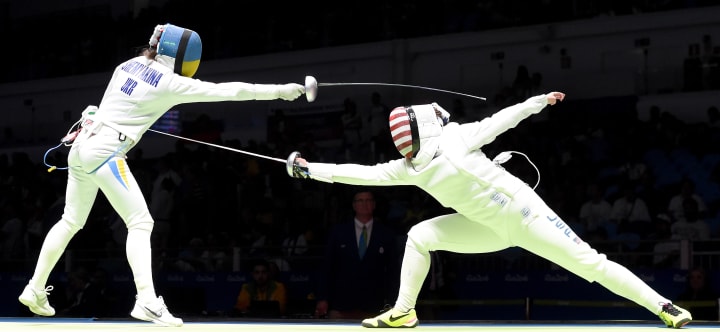Fencing: The Coolest Underrated Sport out There
Very few understand the sport in general (some only hearing from the Olympics). Let's change that.

"Fencing? That's like sword fighting... right?" is a sentence that came out of my own mouth before joining it myself. Ever since I heard the word during my freshman year, it caught my interest. I was very disappointed to find that I was too busy to join that year. However, my schedule opened up enough in my sophomore year to add one after-school activity. I had the option to pick from drama or fencing. Considering this article, I think you can guess to which one I chose.
Before I can even begin to debate the topic of fencing, I believe I should explain a few things about the sport first. Throughout my years wielding a sword, I found that I needed to inform people on different things as they have never heard about fencing before. If you already know of the rules and terms of fencing, feel free to skip down to the next line. If you do read it, just know that I am an épée. If I got some facts wrong, I apologize. In fact, if you can correct my facts, I would highly appreciate it!
---------------------------------
Let us first discuss the three different blades: foil, épée, and sabre.
Foils

Foils Fencing
A foil is known as a light, flexible blade with a small circular bell covering the handle. The rules of foil are complicated, but I will attempt to summarize it to be understandable. In all blades, the fencers are only allowed to hit the target area for a point. The target area in foil is the torso, neck, and back area. Foil fencers wear a lamé (silver vest-like apparel) over their white uniform to demonstrate the location of their target area. If the fencers don't hit their opponent's target area, no point is awarded and they are forced to try again. Another rule in foil is that both players cannot hit each other at the same time. If this happens, only one or neither of the fencers can get a point. The director must use rules of right of way (which are extremely complicated and I won't get into) to determine if a point is awarded and to whom.
Épées

Épées Fencing
The épée is a very different sword from both foil and sabre. The target area for this blade is the entire body—from head to toe. The blade was meant as a dueling sword originally until it has evolved to today's version. This sword handles much more stress and strength, so the blade is much thicker and harder to bend. Fencers must be careful while fencing épée, as their entire body is a possible target. Unlike foil or sabre, right of way is not one of the rules. If both fencers are hit simultaneously, both fencers get a point. This is commonly referred to as a "double-touch."
Sabres

Sabres Fencing (notice the bend in blade)
The sabre is the final blade that needs to be mentioned and is similar to foil with one main difference. Both foil and épée require only the tip of the blade to hit. Sabre, on the other hand, includes the sides of the blade. For instance, foilists and épéeists can only stab their opponents while sabre can slash at them. The target area for sabre includes the head, torso, and back, of which is also shown with a lamé. Right of way appears in sabre with basically the same rules as foil. It is up to the director if a point is awarded and which fencer receives it.
Target Areas

The differences in target areas between the three blades.
Finally, some more basic information about fencing includes bouts. A "bout" is referred to the match that includes two fencers fencing each other and a director to keep track of the score and discipline fencers if they break the rules. A typical bout is up to five points, the first to get to that number wins the bout. The only other way a bout can end is if the time (three minutes) runs out. In fencing, ties cannot finish the bout. There must be a single winner (even in épée with its double touch). If the time runs out with a tie, it goes into priority. Priority is a one minute bout of which a fencer is randomly given priority. If the time goes out before the other can get a point, the one with priority gets the point. If the other can hit in time, they get the point.
---------------------------------
One interesting thing I've found about fencing is the fact that I had to mention everything above. Not every school provides fencing as a club, never mind a sport. As a result, no one understands the sport because it's never been explained to them. Some may even think it's boring to watch. My mother left a tournament I was in because she and my step dad were bored of fencing. I ended up receiving first place in that tournament and my mother wasn't there to witness it simply because she didn't understand the sport.
Fencing is an underrated sport when it shouldn't be. Fencing is an individual sport while being a team sport as well. You fence by yourself, but you have the support of your team behind you. It is also a sport for those who have trouble getting into any of the other sports. I requires strength and strategy in order to do well in the sport. Some can also take it as a stress reliever. Some of the quiet or shy people could be the most aggressive in fencing. It is also a sport that can accept anyone, regardless of experience, weight, height, gender, race, sexuality, nationality. It is an open-minded sport full of extremely nice people.
The fact that fencing is "brushed under the rug" to this day is unnecessary and should be changed. I don't want to force people to join fencing if they do not want to, that is not my intention. I want to allow people to at least have the option to fence. When I was little, I tried softball and soccer. I found that I didn't like them. This is why fencing is so special to me. Unlike the other sports, fencing intrigued me before I even joined the team. Once I did, I enjoyed it. While it may not be the sport for everyone, some may not know that it is until they've tried is at least once. Fencing is one of the most intense parts of the Olympics, so it should be introduced in school as an official sport rather than a under-funded club. My fencing team had to fight for recognition as a sport in my high school. We succeeded in our mission, but we shouldn't have needed to fight in the first place.





Comments
There are no comments for this story
Be the first to respond and start the conversation.